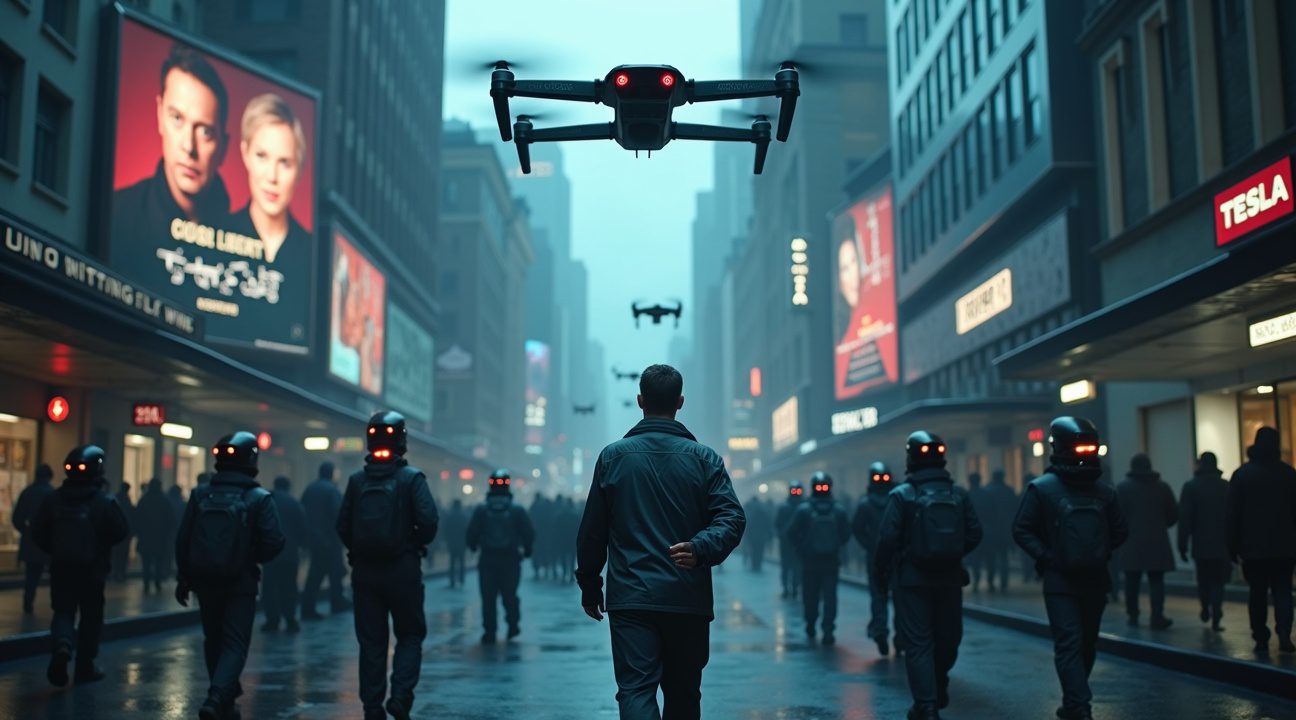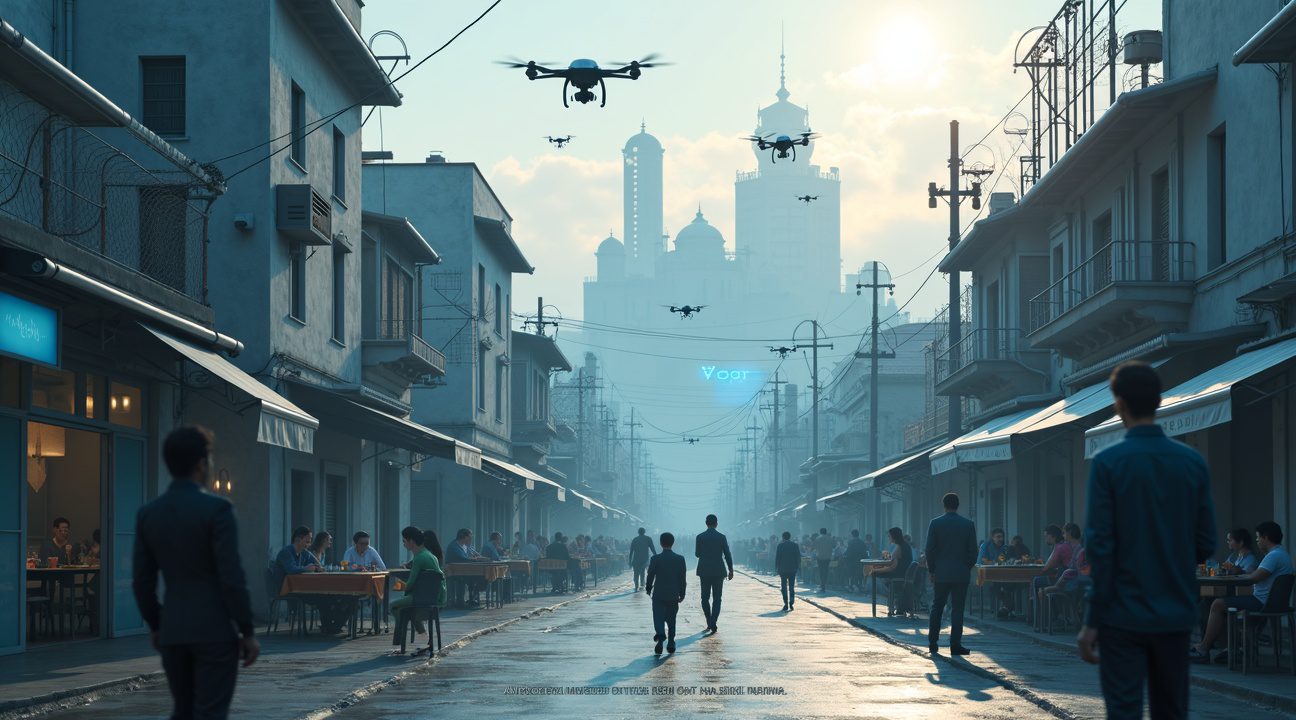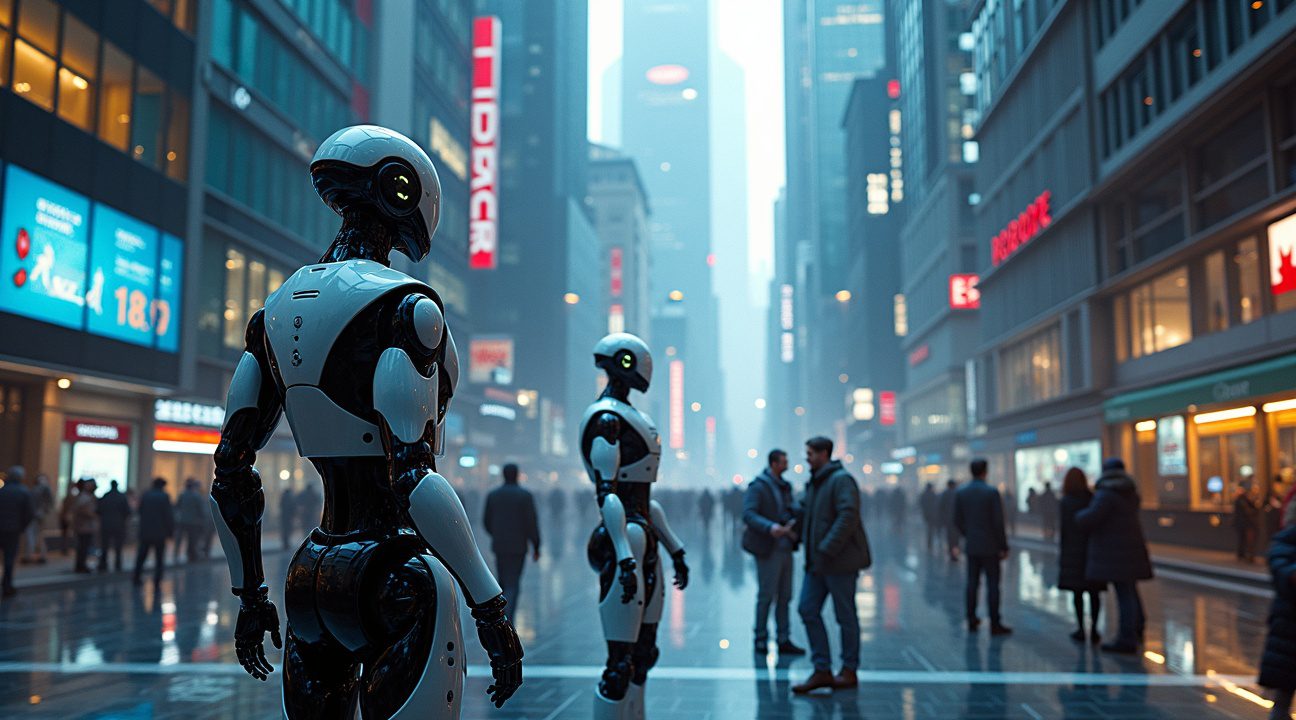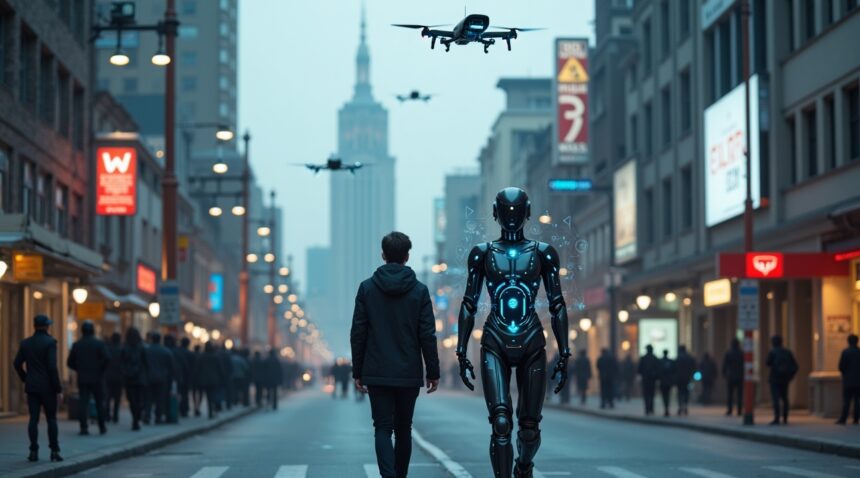Tesla’s Optimus robots could revolutionize criminal justice by replacing traditional prisons with continuous robotic supervision. This concept emerges as law enforcement seeks innovative solutions to reduce incarceration costs while maintaining public safety. The proposal challenges conventional approaches to punishment and rehabilitation through advanced AI surveillance technology.
Key Takeaways
- Tesla’s Optimus robots would provide 24/7 surveillance of released criminals, using AI to monitor behavior patterns and intervene before crimes occur.
- The system would cost an estimated $20,000-$30,000 per robot compared to $35,000 annually for traditional incarceration, potentially offering economic advantages.
- Current technology falls significantly short of Musk’s promises, with existing Optimus robots requiring human oversight and lacking the autonomous capabilities needed for crime prevention.
- The proposal raises severe privacy concerns and civil liberties issues, creating a permanent surveillance state for former inmates that could violate constitutional protections.
- Musk envisions scaling production to millions of robots annually as part of a trillion-dollar robotics market that could fundamentally transform society beyond just criminal justice applications.
Economic Benefits of Robotic Supervision
The financial advantages appear compelling. Traditional incarceration costs taxpayers approximately $35,000 per inmate annually across the United States. Prison overcrowding strains budgets while producing questionable rehabilitation outcomes. Tesla’s robotic alternative offers a one-time purchase price of $20,000-$30,000 per unit, with minimal ongoing operational costs.
This economic model assumes each robot operates effectively for multiple years with standard maintenance. The initial investment recovers quickly when compared to annual prison expenses. States could redirect savings into education, infrastructure, or other public services that address crime’s root causes.
Technical Limitations and Reality Check
Current Optimus prototypes reveal significant gaps between vision and capability. These robots struggle with basic tasks like walking on uneven surfaces or recognizing complex social situations. Advanced crime prevention requires sophisticated behavioral analysis, real-time decision-making, and physical intervention capabilities that don’t exist yet.
The machines need constant human supervision during demonstrations. They can’t distinguish between normal activities and potential criminal behavior. False positives would create unnecessary interventions, while missed signals could allow actual crimes to proceed undetected.
Battery life poses another critical challenge. Current models operate for limited periods before requiring recharging. Criminals could exploit these downtime windows to engage in illegal activities. The technology needs dramatic improvements before deployment becomes feasible.
Privacy and Constitutional Concerns
Perpetual robotic monitoring creates unprecedented surveillance scenarios. Former inmates would lose fundamental privacy rights permanently, even after serving their sentences. This approach contradicts established principles of justice that allow rehabilitation and reintegration into society.
Constitutional protections against unreasonable searches could face severe testing. Courts might struggle to define appropriate boundaries when robots collect continuous data about daily activities, conversations, and personal relationships. The system could expand beyond criminal justice to monitor other populations deemed “at risk.”
Civil liberties organizations express alarm about creating two-tiered citizenship where some people live under constant mechanical observation. This precedent might normalize surveillance culture for broader populations over time.
Implementation Challenges
Deploying millions of robots requires massive infrastructure development. Charging stations, maintenance facilities, and monitoring centers need construction across communities. Local law enforcement agencies must train staff to manage robotic fleets and respond to alerts effectively.
Legal frameworks don’t exist for robotic law enforcement. Legislators must define acceptable intervention methods, data collection limits, and accountability measures when robots make errors. Insurance companies need policies covering robotic malfunctions that cause harm or property damage.
Public acceptance remains uncertain. Communities might resist having crime-monitoring robots operating in their neighborhoods. Property owners could prohibit robots from entering private premises, creating enforcement gaps.
Alternative Applications
The technology could serve positive community functions beyond criminal supervision. Elderly care facilities might use similar robots to monitor patients for falls or medical emergencies. Search and rescue operations could benefit from autonomous units capable of accessing dangerous areas.
Environmental monitoring represents another potential application. Robots could track pollution levels, wildlife populations, or natural disaster damage without human risk. These beneficial uses might help public acceptance while developing necessary technological capabilities.
Future Implications
Success in criminal justice applications could accelerate broader robotics adoption across society. Manufacturing, agriculture, and service industries already explore automation opportunities. Crime prevention robots might normalize human-machine interaction in ways that reshape social structures fundamentally.
The trillion-dollar robotics market Musk envisions extends far beyond law enforcement. Transportation, healthcare, and domestic services could see similar disruption. Society must prepare for workforce displacement and economic transformation accompanying this technological shift.
Scientific and Ethical Considerations
Behavioral prediction algorithms raise questions about determinism and free will. Can machines accurately assess human intentions before actions occur? The margin for error in crime prevention must approach zero to justify restricting individual freedom based on algorithmic predictions.
Research shows recidivism rates vary significantly based on crime type, age, and social support systems. Generic robotic monitoring might prove less effective than targeted interventions addressing specific risk factors. Human counselors and social workers often achieve better rehabilitation outcomes through personal relationships.
The proposal reflects broader tensions between technological innovation and human rights. While efficiency and cost savings appeal to policymakers, preserving dignity and constitutional protections remains essential for legitimate governance.
Tesla’s robotic supervision concept pushes boundaries of what society considers acceptable in criminal justice reform. Whether this vision becomes reality depends on technological breakthroughs, legal developments, and public willingness to accept fundamental changes in how communities handle crime and punishment.
Tesla’s Optimus Robots Could Replace Prisons with 24/7 Robot Surveillance
Elon Musk has proposed a radical alternative to traditional incarceration through Tesla’s Optimus humanoid robots. Musk’s ambitious vision involves assigning these robots to follow released criminals continuously, preventing them from committing future offenses through constant surveillance and intervention.
“You now get a free Optimus and it’s just gonna follow you around and stop you from doing crime,” Musk explained during his public announcement. This system would fundamentally transform criminal justice from detention-based punishment to perpetual monitoring, where robots serve as personal wardens in the outside world.
How Robot Surveillance Would Function
The proposed system would operate through several key mechanisms:
- Continuous physical tracking of individuals throughout their daily activities
- Real-time behavior analysis to identify potential criminal intent
- Immediate intervention capabilities to prevent crimes before they occur
- Data collection on all movements, interactions, and activities
- Integration with law enforcement systems for instant communication
Unlike traditional parole officers who check in periodically, these robots would maintain uninterrupted observation. They’d use advanced sensors, cameras, and artificial intelligence to monitor body language, detect weapons, and assess threatening situations. The robots could physically intervene when necessary, potentially restraining individuals or alerting authorities instantly.
This surveillance approach differs significantly from current ankle monitors or GPS tracking systems. While existing technology monitors location, Musk’s proposal involves active behavioral modification through robotic presence. The psychological impact alone could deter criminal activity, knowing that an artificial observer records every action.
However, this system raises substantial privacy concerns. Individuals would lose virtually all personal space and autonomy, even after completing their sentences. The robots would witness private conversations, family interactions, and intimate moments. This level of surveillance extends far beyond what current parole systems permit and could create a permanent underclass of monitored citizens.
The technology would also introduce new vulnerabilities. Hackers could potentially compromise these surveillance systems, criminals might develop countermeasures, and the robots themselves could malfunction or be damaged. Additionally, Musk’s track record with ambitious timelines suggests this technology may face significant implementation challenges.
Questions remain about who would control these robots, how long surveillance would continue, and what happens when individuals move between jurisdictions. The system could create a society where some people live under permanent robotic supervision while others enjoy complete freedom, fundamentally altering the concept of justice and rehabilitation.
https://www.youtube.com/watch?v=HjGEQo8c_AU
How Tesla’s Crime-Fighting Robots Would Actually Work
Tesla’s Optimus robot, first introduced in 2022, represents a humanoid AI system originally designed for industrial labor and household tasks. Elon Musk’s ambitious vision now extends this technology into criminal monitoring, transforming these robots into mobile security units.
Core Surveillance Capabilities
The crime-fighting version of Optimus would function primarily as an advanced mobile security camera system. These robots would maintain continuous surveillance of designated individuals, using their autonomous AI to track movements and activities throughout the day. The system relies on sophisticated computer vision algorithms to identify and catalog behaviors, creating detailed behavioral profiles for each monitored subject.
Key operational features would include:
- Real-time facial recognition and tracking technology
- Advanced motion detection and pattern analysis
- Audio recording capabilities for contextual evidence gathering
- GPS positioning systems for precise location monitoring
- Night vision and thermal imaging for 24/7 surveillance
- Weather-resistant construction for outdoor operations
Intervention and Response Systems
Beyond passive monitoring, these robots would incorporate active crime prevention measures. The AI system would analyze behavior patterns to predict potentially criminal activities before they occur. When suspicious behavior is detected, the robot could immediately alert law enforcement agencies while simultaneously beginning intervention protocols.
Physical intervention capabilities would include non-lethal restraint methods and the ability to position themselves between potential victims and monitored individuals. The robots would feature emergency communication systems that connect directly to police dispatch centers, providing real-time updates and GPS coordinates.
Wireless autonomy ensures these units can operate independently for extended periods, while automated recharge protocols allow them to dock at designated charging stations without human intervention. Each robot maintains constant connectivity to central monitoring systems, enabling coordinated responses across multiple units.
The estimated cost of $20,000 to $30,000 per Optimus robot makes this approach potentially more economical than traditional human surveillance methods. However, Musk’s track record with ambitious timelines suggests implementation challenges may arise. Critics also point to concerns about privacy and the potential for technical malfunctions in high-stakes situations.
The integration of machine learning allows these robots to continuously improve their predictive accuracy, adapting to individual behavioral patterns and environmental factors. This creates a personalized monitoring system that becomes more effective over time.
Current Technology Falls Short of Crime Prevention Promises
Despite Musk’s bold claims, Tesla’s Optimus robots remain far from the autonomous crime-fighting machines he envisions. I’ve observed that recent demonstrations reveal significant limitations in the current technology, with robots requiring constant human oversight through teleoperation or remaining tethered to power sources for basic interactions. These fundamental dependencies highlight the substantial gap between marketing promises and technological reality.
The prediction and intervention capabilities Musk describes exist purely in theoretical discussions. Current AI systems can’t accurately predict human behavior with the precision needed for crime prevention, and no existing robot possesses the sophisticated decision-making abilities required for real-world intervention scenarios. Musk’s ambitious statements often outpace the actual capabilities of his companies’ technologies.
Security Vulnerabilities Pose Major Risks
Implementation of robot surveillance systems would demand complex security infrastructure that doesn’t currently exist at scale. Essential components would include:
- Multi-layered data encryption to protect citizen information
- Advanced AI firewalls preventing unauthorized system access
- Continuous real-time monitoring of robot networks
- Fail-safe mechanisms ensuring immediate shutdown capabilities
These security requirements create their own vulnerabilities. Hackers could potentially compromise the entire network, turning protective robots into dangerous threats. I find it particularly concerning that Musk’s track record shows a pattern of overpromising on technological timelines while underestimating implementation challenges.
The computational power needed for real-time crime prediction would strain current AI systems beyond their limits. Processing thousands of behavioral variables, environmental factors, and social indicators simultaneously requires processing capabilities that exceed what’s commercially available. Even Tesla’s Full Self-Driving technology struggles with basic driving scenarios, making crime prediction seem impossibly ambitious.
Battery technology presents another insurmountable obstacle. Optimus robots can’t operate continuously for extended periods without recharging, severely limiting their effectiveness as surveillance tools. Critics have noted how Musk often overlooks practical limitations when making public statements about future capabilities.
Physical intervention capabilities remain completely underdeveloped. Current humanoid robots lack the strength, speed, or coordination needed to safely restrain individuals or respond to emergency situations. Their movements are slow and predictable, making them ineffective for any scenario requiring quick response times.
Network vulnerabilities could create catastrophic scenarios where compromised robots harm innocent people instead of preventing crime. Cybersecurity experts consistently warn that interconnected robot networks present attractive targets for malicious actors seeking to cause widespread disruption.
Privacy Concerns and the “Pre-Crime” Dilemma
Assigning robots to monitor former inmates around the clock creates unprecedented privacy violations that challenge fundamental civil liberties. These Tesla robots would essentially transform rehabilitation into perpetual punishment, stripping ex-convicts of their basic right to privacy and personal autonomy after they’ve served their sentences.
The Challenge of Predicting Criminal Intent
The technology faces an impossible ethical puzzle: distinguishing between normal behavior and criminal intent. Robots would need to analyze countless daily actions and determine which ones suggest future criminal activity. This creates a dangerous precedent where people face consequences for thoughts or behaviors that haven’t actually harmed anyone.
Critics draw stark comparisons to dystopian fiction, particularly scenarios depicted in shows like Black Mirror, where constant surveillance destroys human dignity. The concept mirrors problematic “pre-crime” enforcement systems that punish possibilities rather than actual wrongdoing. Elon Musk’s expanding influence in technology raises additional concerns about concentrating such power in private hands.
Corporate Control Over Public Safety
Perhaps most troubling is how this system would transfer significant law enforcement authority to a private corporation. Tesla would essentially become a shadow police force, making critical decisions about citizen behavior without traditional oversight mechanisms that govern public law enforcement.
The implications extend beyond individual privacy violations. Such surveillance could create chilling effects where people self-censor normal activities out of fear their robot monitors might misinterpret innocent actions as suspicious. Former inmates might avoid legitimate activities like visiting certain neighborhoods or associating with particular groups, simply because algorithms flag these behaviors as risk factors.
Musk’s ambitious ventures often push boundaries, but this proposal crosses into territory that threatens constitutional protections against unreasonable searches and surveillance. The plan lacks clear accountability structures for when robots make errors or violate civil rights.
Legal experts question whether such comprehensive monitoring violates Fourth Amendment protections and due process rights. The system would create a two-tier justice system where some citizens live under constant surveillance while others enjoy privacy rights. This disparity undermines principles of equal treatment and rehabilitation that form the foundation of modern criminal justice systems.
Musk’s controversial decisions often generate significant backlash, and this proposal appears headed for similar criticism from privacy advocates, civil rights organizations, and legal scholars who recognize its fundamental incompatibility with democratic values.

Comparing Robot Surveillance to Traditional Criminal Justice
Traditional criminal justice systems rely heavily on imprisonment and confinement as primary methods for managing convicted offenders. These approaches involve housing individuals in correctional facilities with human supervision, which generates significant financial burdens for taxpayers and creates lasting social consequences for both offenders and their communities. The current model requires substantial infrastructure, staffing, and ongoing operational costs that strain government budgets across the country.
Musk’s proposed robot surveillance system would fundamentally transform this approach by eliminating the need for physical prison cells. Instead of confining individuals to specific locations, Tesla’s robots would provide continuous monitoring and intervention capabilities that follow released criminals throughout their daily activities. This autonomous system would theoretically operate around the clock without the limitations of human supervisors, who require breaks, shifts, and competitive salaries.
The Humanity Debate
Proponents of Musk’s vision argue that robot surveillance offers a more humane alternative to traditional incarceration. They point out that individuals could maintain their freedom of movement while still being held accountable for their actions. This approach would allow former criminals to continue working, maintaining family relationships, and contributing to society rather than being completely removed from their communities. Musk’s ambitious plans often challenge conventional thinking about complex social problems.
Critics, however, view this system as a form of technological rehabilitation that borders on dystopian control. They argue that constant robotic surveillance could create psychological stress and social isolation that might be worse than temporary imprisonment. The idea of being perpetually watched by machines raises questions about human dignity and the right to privacy, even for those who have committed crimes.
Efficiency and Cost Considerations
Supporters emphasize that existing criminal justice systems are outdated, expensive, and inefficient compared to the proposed robotic alternative. Current incarceration costs taxpayers approximately $35,000 per prisoner annually, not including court proceedings, legal representation, and post-release supervision. Robot surveillance could potentially reduce these expenses while providing more consistent monitoring than human parole officers can deliver.
The efficiency argument extends beyond financial considerations. Traditional systems often fail to prevent recidivism, with many released prisoners committing new crimes within months of their release. Continuous robotic supervision could theoretically intervene before new criminal acts occur, potentially protecting both society and the individuals being monitored from making choices that would result in additional legal consequences.

Tesla’s Trillion-Dollar Vision for a Robot-Dominated Future
Tesla’s ambitious manufacturing goals for the Optimus robot paint a picture of unprecedented scale in robotics production. The company plans to produce up to 1 million Optimus robots annually, with Elon Musk setting his sights on eventually scaling production to 10 million units and beyond. This manufacturing target represents a massive leap from prototype development to mass-market deployment.
Musk positions the Optimus robot as potentially Tesla’s most significant and valuable product line, projecting a future market capitalization between $25 trillion and $30 trillion. This valuation dwarfs traditional automotive markets and signals Tesla’s transformation from an electric vehicle company into a comprehensive robotics enterprise. The financial projections suggest Musk believes humanoid robots will create entirely new economic categories rather than simply replacing existing products.
A World Transformed by Ubiquitous Robotics
The vision extends far beyond manufacturing numbers to encompass fundamental societal changes. Musk envisions humanoid robots becoming as common as smartphones in daily life, creating what amounts to a robot-saturated society. This transformation would impact multiple critical sectors:
- Justice systems could see robots deployed for continuous monitoring and crime prevention
- Labor markets would face widespread automation across industries previously requiring human dexterity
- Personal companionship might shift as robots provide consistent availability and programmed responses
- Economic productivity could increase exponentially through 24/7 robot operation cycles
The scope of this vision suggests robots wouldn’t merely assist humans but would fundamentally alter how society functions. Musk’s ambitious projects typically aim to reshape entire industries, and the Optimus initiative appears designed to transform civilization itself.
Current smartphone adoption rates provide a blueprint for how quickly transformative technology can penetrate global markets. Musk’s comparison suggests he anticipates similar adoption curves for humanoid robots, though the infrastructure requirements and cost barriers present different challenges than mobile devices faced.
The trillion-dollar market projections indicate Musk expects robotics to become the largest industry in human history. This calculation factors in not just robot sales but the economic value generated by robot labor across all sectors. Such projections assume widespread acceptance of robot integration into previously human-only domains, including sensitive areas like criminal justice monitoring and personal relationships.

Sources:
KOHA.net, “Musk: Tesla’s robots could follow people to prevent crime”
unionrayo.com, “Elon Musk proposes to free prisoners and use this new Tesla technology to monitor them in real time”
Electrek, “Elon Musk says let criminals out of prison and give them a robot stalker instead”
4CA, “Elon Musk Proposes Optimus Robots as Prison Alternative …”
YouTube, “Tesla Bot Gen 3 BEST Highlights At 2025 Tesla Annual Shareholder …”
ISNA.ir, “Tesla’s CEO Elon Musk Criticized for Proposed Use of Robots in Crime Prevention and Criminal Release”


